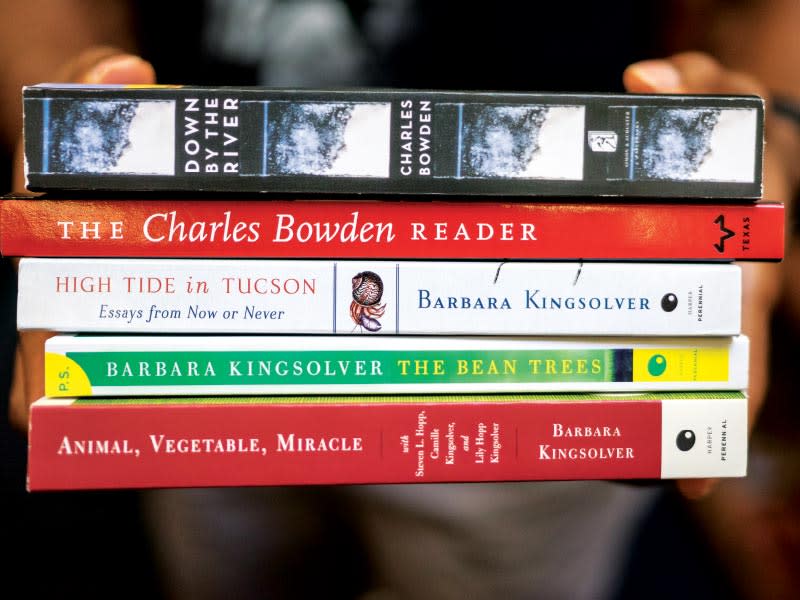By Margaret Regan
Jack Kerouac may not have been the first writer to be charmed by Tucson, but his description of this desert literary haven is among the most poetic.
“Tucson is situated in beautiful mesquite riverbed country, overlooked by the snowy Catalina range…,” the beat writer declared in his masterwork, “On the Road,” published in 1957.
Sixty-two years later, the landscape is just as lovely and the city is abuzz with book readings, writing programs, bookstores, publishing houses, and one of the biggest book fairs in the country—the annual Tucson Festival of Books. And the old Mexican town turned cool modern hub has been home to legions of best-selling authors.
An environmentalist and champion of social justice, novelist Barbara Kingsolver set her first book, The Bean Trees, right here in Tucson. Like the Tucson authors Edward Abbey (Desert Solitaire) and Joseph Wood Krutch (The Desert Year) before him, the late Southwestern sage Charles Bowden wrote fierce books advocating for the fragile desert landscape. After he died, the locals returned the favor by giving his name to a community center in the Santa Catalinas, the mountains he celebrated in Frog Mountain Blues.

Tucson Festival of Books
Tucson’s flat desert and soaring Sky Island mountains—the assets that transfixed Kerouac—are woven into the city’s romance with the written word. Many writers here came from the East or the Midwest and fell in love not only with the big skies and long views, but with desert life forms from the saguaro cactus to the Gila monster. Ecologist Gary Paul Nabhan, born in Indiana, and nature essayist Alison Hawthorne Deming (yes, that Hawthorne!), who hails from Connecticut, both lionize that landscape. Tom Miller, raised in DC, zeroes in on the borderlands.
The city’s energetic blend of Mexican, Native American, and European cultures is a driver of provocative poetry and prose. Laguna Pueblo novelist Leslie Marmon Silko, Tohono O’odham poet Ofelia Zepeda, and Mexican American nonfiction writer Patricia Martin all explore cultural traditions and conflicts. (Zepeda, Silko, and Nabhan have all won the MacArthur genius award.)
Tucson also lays claim to mystery author J.A. Jance, novelist and screenwriter Larry McMurtry, and recent star Victor Lodato, who live in the city part-time, along with a permanent contingent of poets, including Luci Tapahonso and Joy Williams. The city even has a poet laureate; T.C. Tolbert currently holds the two-year post.

Antigone Books
And speaking of poetry, the University of Arizona Poetry Center is a unique institution that combines a major library and archive with a packed schedule of readings by acclaimed visiting poets and authors. No less a poet than Robert Frost opened the center with a live reading back in 1960. Numerous poets venture to Tucson each April for the Tucson Poetry Festival, which has celebrated voluminous verse since 1982.
The powerhouse creative writing program at the university does its part by hiring writers and producing new ones; its most famous alumnus, the late David Foster Wallace, stunned the literary world with his Infinite Jest. The university also hosts the Tucson Festival of Books each March, with renowned authors of the caliber of Luis Alberto Urrea and Joyce Carol Oates flying in to speak. Typically, the festival audience tops 100,000—though the campus has plenty of room to roam.
These devoted readers also flock to Tucson’s thriving bookstores. At the three massive stores in the Bookmans used-book empire, fans buy and sell books of all kinds. Connoisseurs patronize the Book Stop, a near-Dickensian operation packed with rare and vintage books, maps, and sheet music.
Antigone Books, the 45-year-old flagship of Tucson’s new-book emporiums, stages weekly readings and sponsors multiple book clubs. When the beloved store went up for sale recently, Tucsonans fearful of losing a feisty independent voice rushed to save it. Within four days, local book lovers had raised enough money to clinch a deal that helped three young women staffers buy the store—and ensured its survival for another generation of bibliophiles.
Explore the arts in Tucson
